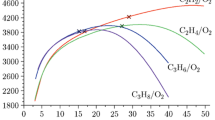Abstract
Extensive data on the length of the deflagration-to-detonation transition (DDT) are obtained for a wide range of explosive gas mixtures of acetylene, propane-butane, and methane with oxygen in tubes with constant and constricting cross sections. For the fuel-oxygen mixtures examined, it is found that the DDT length can be reduced to one tube diameter by using a volume system of obstacles with the size and distance between the obstacles being commensurable with the cell size of multifront detonation in these mixtures. The optimal mixture for deposition is found to be an explosive propane-butane mixture with oxygen in which the fraction of propane-butane is ≈25%.
Similar content being viewed by others
References
Yu. A. Nikolaev and P. A. Fomin, “Analysis of equilibrium flows of chemically reacting gases,” Combust., Expl., Shock Waves, 18, No. 1, 53–58 (1982).
A. K. Oppenheim and P. A. Urtiew, “Experimental observations of the transition to detonation in an explosive gas,” Proc. Roy. Soc. A, 295, 13–28 (1966).
Ya. B. Zel’dovich, V. B. Librovich, G. M. Makhviladze, and G. M. Sivashinskii, “On the onset of detonation in a nonuniformly heated gas,” J. Appl. Mech. Tech. Phys., 11, No. 2, 264–270 (1970).
N. N. Smirnov, V. F. Nikitin, A. P. Boichenko, et al., “Control of deflagration to detonation transition in gaseous systems,” in: G. Roy (ed.), Control of Detonation Processes, ELEX, Moscow (2000), pp. 2–6.
A. M. Khokhlov, E. S. Oran, and G. O. Thomas, “Numerical simulation of deflagration-to-detonation transition: The role of shock-flame interactions in turbulent flames,” Combust. Flame, 117, 323–339 (1999).
E. E. Meshkov, “Instability on a shock-wave accelerated interface of two gases,” Izv. Akad. Nauk SSSR, Mekh. Zhidk. Gaza, No. 5, 151–158 (1969).
R. D. Richtmyer, “Taylor instability in shock acceleration of compressible fluids,” Comm. Pure Appl. Math., 13, 297–319 (1960).
A. A. Vasil’ev, Yu. A. Nikolaev, and V. Yu. Ul’yanitskii, “Critical energy of initiation of a multifront detonation,” Combust., Expl., Shock Waves, 15, No. 6, 768–775 (1979).
V. Yu. Ul’yanitskii, “Closed model of direct initiation of gas detonation taking account of instability. I. Point initiation,” Combust., Expl., Shock Waves, 16, No. 3, 331–341 (1980).
V. Yu. Ul’yanitskii, “Closed model of direct initiation of gas detonation taking account of instability. II. Nonpoint initiation,” Combust., Expl., Shock Waves, 16, No. 4, 427–434 (1980).
K. I. Shchelkin, “Two types of unstable combustion,” Zh. Exp. Teor. Fiz., 36, 600–606 (1959).
T. P. Gavrilenko, “Deflagration-to-detonation transition in acetylene-based mixtures,” Fiz. Goreniya Vzryva, 16, No. 5, 148–149 (1980).
A. A. Vasil’ev, “Estimation of critical conditions for the deflagration-to-detonation transition,” Combust., Expl., Shock Waves, 42, No. 2, 205–209 (2006).
V. Yu. Ul’yanitskii, “Role of ‘flashing’ and transversewave collisions in the evolution of a multifrontal detonation-wave structure in gases,” Combust., Expl., Shock Waves, 17, No. 2, 227–232 (1981).
A. A. Vasil’ev and Yu. A. Nikolaev, “Model of the nucleus of a multifront gas detonation,” Combust., Expl., Shock Waves, 12, No. 5, 667–674 (1976).
A. A. Vasil’ev and V. V. Grigor’ev, “Critical conditions for gas detonation in sharply expanding channels,” Combust., Expl., Shock Waves, 16, No. 5, 579–585 (1980).
V. Yu. Ul’yanitskii, A. A. Vasil’ev, T. P. Gavrilenko, et al., “Tube of a facility for gas deposition of coatings,” Author’s Certificate No. 1072320 (1983).
Author information
Authors and Affiliations
Corresponding author
Additional information
__________
Translated from Fizika Goreniya i Vzryva, Vol. 47, No. 1, pp. 92–98, January–February, 2011.
Rights and permissions
About this article
Cite this article
Gavrilenko, T.P., Ul’yanitskii, V.Y. Application of propane-butane in detonation deposition facilities. Combust Explos Shock Waves 47, 81–86 (2011). https://doi.org/10.1134/S0010508211010114
Received:
Revised:
Published:
Issue Date:
DOI: https://doi.org/10.1134/S0010508211010114




